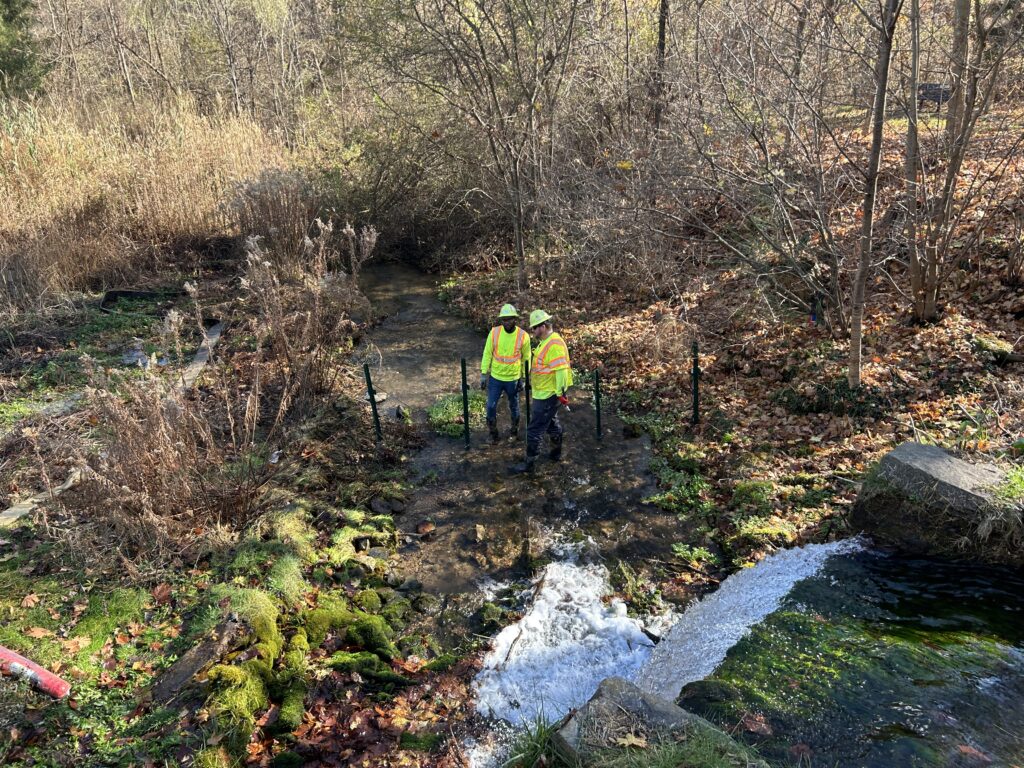Problem
A natural spring dam in a Pennsylvania township was experiencing significant water infiltration through the flagstones that made up its structure. Over time, the constant flow of water eroded the mortar in this 60-foot-long, 8-foot-tall, and 6-foot-wide dam, creating voids within the structure that allowed water to pass through unchecked. This dam holds historical significance, as it was built around a natural spring that served as a vital water source for the Lenni-Lenape people, who inhabited a nearby village and recognized its importance long before European settlement.
Previous repair efforts included the addition of a concrete apron to reinforce the dam. However, this solution proved temporary and ultimately failed, necessitating a new, long-term solution that would preserve the integrity and historical value of the site. Later, European settlers also relied on the spring, continuing its legacy as an essential natural resource.
Solution
Utility Services Group (USG) was contacted to address the issue and implement a solution that would restore the dam’s structural integrity without compromising its historic elements.
To begin the project, USG diverted 2000 gallons of water per minute using a bypass pump to create a dry work area. Once the water was diverted, an assessment of the dam revealed the extent of the voids and infiltration points.
USG employed a two-part strategy to stabilize and seal the dam. On the stream-facing side of the dam, dual-component polyurethane Terrathane™ 24-003 was sprayed to fill voids within the structure. This injection process was conducted at multiple depths to ensure comprehensive coverage and stabilization.
On the opposite side of the dam, USG used single-component polyurethane Terra-Lok™ 24-120 to seal the structure.
The polyurethane was injected within the dam to create a durable barrier against water infiltration. Throughout the process, USG maintained a strong focus on preserving the cleanliness and integrity of the historic site. A net was placed downstream to prevent any polyurethane materials from contaminating the waterway. Additionally, after the injection was completed, a wire brush was used to remove any excess polyurethane from the dam’s surface to maintain its historical appearance.
Results
The stabilization and sealing of the historic natural spring dam were successfully completed within three days. USG restored the dam’s structural integrity without the need for excavation or removal of any historical elements.
This solution provided a cost-effective option for the township, staying within budget while delivering long-term stability. By using advanced polyurethane materials, USG was able to reestablish the dam’s strength and prevent further water infiltration.
Preservation of the historical site was prioritized throughout the project. USG’s respectful approach ensured that the work was conducted with minimal disruption to the dam’s appearance and surrounding environment. The final step of the project involves a mason applying a layer of mortar over the polyurethane to further enhance the dam’s structural and aesthetic qualities.
The project’s success demonstrates USG’s expertise in addressing challenging infrastructure repairs while maintaining a strong commitment to historical preservation and environmental stewardship.

